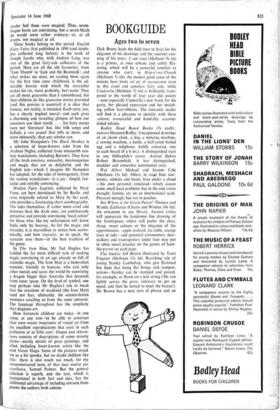Fathers to the man
COLIN MacINNES
English Fairy Tales collected by Joseph Jacobs (Bodley Head 42s) The Black Monkey John Hampden (Deutsch 21s) Hindoo Fairy ' Legends collected by Mary Frere (Constable 14s 6d) The Iron Man Ted Hughes (Faber 13s 6d) Shapes and Adventures Geoffrey and Jane Grigson (John Marshbank 35s) Since books largely replaced the fireside story- teller or, for adults, the wandering bard, one of the finest periods for the publication of children's stories was the middle and late nine- teenth century—and for three reasons. First, city dwellers were not yet irrevocably removed from the places of their country origins. A woodcutter living in a forest, for instance, seems today an almost exotic personage; a hundred years ago he was still around, and not far from the city.
Next, these stories were collected all over Europe—and, as we shall see, Asia—at a time when, thanks to popular education and indus- trialisation, the oral tradition of their telling was in decline. And fortunately, just as there were those who collected vanishing folk songs and dances, so were there amateur anthropolo- gists who collected traditional stories not from old books, but from old lips.
Lastly, in the early industrial era, before the products of science became themselves miracu- lous, it was still possible to endow inanimate objects with magical qualities and make the
reader feel these were magical. Thus, seven- league boots are convincing, but a seven-Mach jet would seem rather ordinary—or, at all events, not magical at all.
Three books belong to this period. English Fairy Tales, first published in 1890 (and doubt- less collected long before), is the work of Joseph Jacobs who, with Andrew Lang, was one of the great fairy-tale collectors of the period. Here are all the old favourites, from 'Tom Thumb' to 'Jack and the Beanstalk'; and what strikes me most, on reading them again for the first time since childhood, is the ad- mirable brevity with which the storyteller makes his (or, more probably, her) point. They are all more gruesome than I remembered, but then children do like gruesome stories provided (and this proviso is essential) it is clear that fantasy, not reality, is intended. Each story, too, has a clearly implied moral—and each gives a charming and revealing glimpse of how our ancestors saw their world . . . for fairy stories were not 'literature' but, like folk songs and ballads, a vox populi that tells us more, and more intimately, than any scholar can.
Mr John Hampden's The Black Monkey is a selection of lesser-known tales from the Arabian Nights, collected from nineteenth cen- tury translations, including Burton's. They have all the Arab courtesy, sensuality, inconsequence and magic that are so delightful, and the English text—which I imagine Mr Hampden has adapted, for the sake of homogeneity, from the various translations—is a joy : limpid, fan- tastic and entirely convincing.
Hindoo Fairy Legends, collected by Mary Frere, are here introduced by Sir Bartle, and were originally related to Mary by her ayah, who provides a fascinating short autobiography. The tales themselves, if rather more cruel and tortuous than the Arab ones, are continuously attractive and provide convincing 'local colour' for those who, like my unfortunate self, know India only by hearsay. As for the magic and miracles, it is marvellous to notice how econo- mically, and how logically, so to speak, the narrator uses them—in the best tradition of the genre. . - In The Iron Man, Mr Ted Hughes has tackled the far more difficult task of making magic convincing in an age already so full of scientific magic. The Iron Man is a benevolent monster, friendly to humans, who eats only other metals and saves the world by outwitting a dragon bigger than Australia that descends from outer space. On the level of symbol, one may perhaps take Mr Hughes's tale to mean that the creations of mankind (the Iron Man) need not fear, ultimately, the science-fiction monsters assailing us from the outer universe. The language throughout has the simplicity that disguises art.
How fortunate children are today—in one sense, at any rate—to be able to construct their own musee imaginaire of visual art .from the excellent reproductions that exist in such profusion at so little cost! Shapes and Adven- tures consists of descriptions of some seventy plates—mostly details of great paintings, and often including lesser-known- artists like the poet Victor Hugo. Some of the pictures struck me as a bit spooky, but no doubt children like this: there is also much too much, for my unreconstructed taste, of that faux maitre par. excellence, Samuel Palmer. But the general selection is superb, and the text, which is instructional in both fact and idea, has the additional advantage of including extracts from Poems the authors both admires











































 Previous page
Previous page